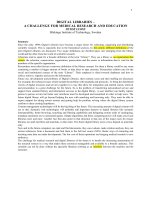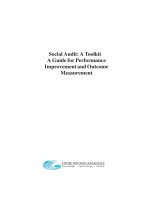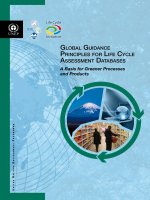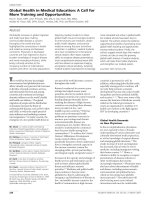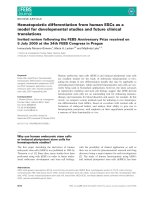A technology for crystal growth and materials processing
Bạn đang xem bản rút gọn của tài liệu. Xem và tải ngay bản đầy đủ của tài liệu tại đây (18.6 MB, 891 trang )
HANDBOOK OF
HYDROTHERMAL TECHNOLOGY
A Technology for Crystal Growth and
Materials Processing
by
K. Byrappa
University of Mysore
Manasagangotri
Mysore, India
and
Masahiro Yoshimura
Tokyo Institute of Technology
Yokohama, Japan
NOYES PUBLICATIONS
Park Ridge, New Jersey, U.S.A.
WILLIAM ANDREW PUBLISHING, LLC
Norwich, New York, U.S.A.
JMR
10-Nov-00
Copyright © 2001 by Noyes Publications
No part of this book may be reproduced or
utilized in any form or by any means, electronic
or mechanical, including photocopying, recording
or by any information storage and retrieval
system, without permission in writing from the
Publisher.
Library of Congress Catalog Card Number: 00-021998
ISBN: 0-8155-1445-X
Printed in the United States
Published in the United States of America by
Noyes Publications / William Andrew Publishing, LLC
13 Eaton Avenue
Norwich, NY 13815
1-800-932-7045
www.knovel.com
10 9 8 7 6 5 4 3 2 1
Library of Congress Cataloging-in-Publication Data
Byrappa, K.
Handbook of Hydrothermal Technology / by K. Byrappa and Masahiro
Yoshimura.
p. cm.
Includes bibliographical references and index.
ISBN 0-8155-1445-X
1. Crystallization. 2. Crystal growth. I. Title
QD921.B97
2001
548'.5--dc21
00-021998
CIP
To
Sunitha and Akiko
NOTICE
To the best of our knowledge the information in this publication is
accurate; however the Publisher does not assume any responsibility
or liability for the accuracy or completeness of, or consequences
arising from, such information. This book is intended for informational
purposes only. Mention of trade names or commercial products does
not constitute endorsement or recommendation for use by the Publisher. Final determination of the suitability of any information or
product for use contemplated by any user, and the manner of that
use, is the sole responsibility of the user. We recommend that
anyone intending to rely on any recommendation of materials or
procedures mentioned in this publication should satisfy himself as
to such suitability, and that he can meet all applicable safety and
health standards.
vi
MATERIALS SCIENCE AND PROCESS TECHNOLOGY SERIES
Series Editors
Gary E. McGuire, Microelectronics Center of North Carolina
Stephen M. Rossnagel, IBM Thomas J. Watson Research Center
Rointan F. Bunshah, University of California, Los Angeles (1927–1999), founding editor
Electronic Materials and Process Technology
CHARACTERIZATION OF SEMICONDUCTOR MATERIALS, Volume 1: edited by Gary E.
McGuire
CHEMICAL VAPOR DEPOSITION FOR MICROELECTRONICS: by Arthur Sherman
CHEMICAL VAPOR DEPOSITION OF TUNGSTEN AND TUNGSTEN SILICIDES: by
John E. J. Schmitz
CHEMISTRY OF SUPERCONDUCTOR MATERIALS: edited by Terrell A. Vanderah
CONTACTS TO SEMICONDUCTORS: edited by Leonard J. Brillson
DIAMOND CHEMICAL VAPOR DEPOSITION: by Huimin Liu and David S. Dandy
DIAMOND FILMS AND COATINGS: edited by Robert F. Davis
DIFFUSION PHENOMENA IN THIN FILMS AND MICROELECTRONIC MATERIALS:
edited by Devendra Gupta and Paul S. Ho
ELECTROCHEMISTRY OF SEMICONDUCTORS AND ELECTRONICS: edited by John
McHardy and Frank Ludwig
ELECTRODEPOSITION: by Jack W. Dini
HANDBOOK OF CARBON, GRAPHITE, DIAMONDS AND FULLERENES: by Hugh O.
Pierson
HANDBOOK OF CHEMICAL VAPOR DEPOSITION, Second Edition: by Hugh O.
Pierson
HANDBOOK OF COMPOUND SEMICONDUCTORS: edited by Paul H. Holloway and
Gary E. McGuire
HANDBOOK OF CONTAMINATION CONTROL IN MICROELECTRONICS: edited by
Donald L. Tolliver
HANDBOOK OF DEPOSITION TECHNOLOGIES FOR FILMS AND COATINGS, Second Edition: edited by Rointan F. Bunshah
HANDBOOK OF HARD COATINGS: edited by Rointan F. Bunshah
HANDBOOK OF ION BEAM PROCESSING TECHNOLOGY: edited by Jerome J.
Cuomo, Stephen M. Rossnagel, and Harold R. Kaufman
HANDBOOK OF MAGNETO-OPTICAL DATA RECORDING: edited by Terry McDaniel
and Randall H. Victora
HANDBOOK OF MULTILEVEL METALLIZATION FOR INTEGRATED CIRCUITS: edited by Syd R. Wilson, Clarence J. Tracy, and John L. Freeman, Jr.
HANDBOOK OF PLASMA PROCESSING TECHNOLOGY: edited by Stephen M.
Rossnagel, Jerome J. Cuomo, and William D. Westwood
HANDBOOK OF POLYMER COATINGS FOR ELECTRONICS, Second Edition: by
James Licari and Laura A. Hughes
HANDBOOK OF REFRACTORY CARBIDES AND NITRIDES: by Hugh O. Pierson
HANDBOOK OF SEMICONDUCTOR SILICON TECHNOLOGY: edited by William C.
O’Mara, Robert B. Herring, and Lee P. Hunt
vii
viii Series
HANDBOOK OF SEMICONDUCTOR WAFER CLEANING TECHNOLOGY: edited by Werner
Kern
HANDBOOK OF SPUTTER DEPOSITION TECHNOLOGY: by Kiyotaka Wasa and
Shigeru Hayakawa
HANDBOOK OF THIN FILM DEPOSITION PROCESSES AND TECHNIQUES: edited by
Klaus K. Schuegraf
HANDBOOK OF VACUUM ARC SCIENCE AND TECHNOLOGY: edited by Raymond L.
Boxman, Philip J. Martin, and David M. Sanders
HANDBOOK OF VLSI MICROLITHOGRAPHY: edited by William B. Glendinning and
John N. Helbert
HIGH DENSITY PLASMA SOURCES: edited by Oleg A. Popov
HYBRID MICROCIRCUIT TECHNOLOGY HANDBOOK, Second Edition: by James J.
Licari and Leonard R. Enlow
IONIZED-CLUSTER BEAM DEPOSITION AND EPITAXY: by Toshinori Takagi
MOLECULAR BEAM EPITAXY: edited by Robin F. C. Farrow
SEMICONDUCTOR MATERIALS AND PROCESS TECHNOLOGY HANDBOOK: edited
by Gary E. McGuire
ULTRA-FINE PARTICLES: edited by Chikara Hayashi, R. Ueda and A. Tasaki
WIDE BANDGAP SEMICONDUCTORS: edited by Stephen J. Pearton
Ceramic and Other Materials—Processing and Technology
ADVANCED CERAMIC PROCESSING AND TECHNOLOGY, Volume 1: edited by Jon
G. P. Binner
CEMENTED TUNGSTEN CARBIDES: by Gopal S. Upadhyaya
CERAMIC CUTTING TOOLS: edited by E. Dow Whitney
CERAMIC FILMS AND COATINGS: edited by John B. Wachtman and Richard A. Haber
CORROSION OF GLASS, CERAMICS AND CERAMIC SUPERCONDUCTORS: edited
by David E. Clark and Bruce K. Zoitos
FIBER REINFORCED CERAMIC COMPOSITES: edited by K. S. Mazdiyasni
FRICTION AND WEAR TRANSITIONS OF MATERIALS: by Peter J. Blau
HANDBOOK OF CERAMIC GRINDING AND POLISHING: edited by Ioan D. Marinescu,
Hans K. Tonshoff, and Ichiro Inasaki
HANDBOOK OF HYDROTHERMAL TECHNOLOGY: edited by K. Byrappa and Masahiro
Yoshimura
HANDBOOK OF INDUSTRIAL REFRACTORIES TECHNOLOGY: by Stephen C. Carniglia
and Gordon L. Barna
SHOCK WAVES FOR INDUSTRIAL APPLICATIONS: edited by Lawrence E. Murr
SOL-GEL TECHNOLOGY FOR THIN FILMS, FIBERS, PREFORMS, ELECTRONICS
AND SPECIALTY SHAPES: edited by Lisa C. Klein
SOL-GEL SILICA: by Larry L. Hench
SPECIAL MELTING AND PROCESSING TECHNOLOGIES: edited by G. K. Bhat
SUPERCRITICAL FLUID CLEANING: edited by John McHardy and Samuel P. Sawan
Other Related Titles
HANDBOOK OF PHYSICAL VAPOR DEPOSITION (PVD) PROCESSING: by Donald M. Mattox
JMR- 10-Nov-00
Preface
The term hydrothermal is purely of geological origin. It was first
used by the British geologist, Sir Roderick Murchison (1792–1871), to
describe the action of water at elevated temperature and pressure in
bringing about changes in the earth’s crust, and leading to the formation of
various rocks and minerals. Geologists carried out the earliest work on the
hydrothermal technique in the 19th century in order to understand the
genesis of rocks and minerals by simulating the natural conditions existing
under the earth crust. However, materials scientists popularized the technique, particularly during 1940s. Schafhautl who obtained quartz crystals
upon freshly precipitated silicic acid in a papin’s digestor carried out the
first hydrothermal synthesis in 1845. Subsequently, hydrothermal synthesis of a wide variety of minerals was carried out, especially in Europe.
The largest-known single crystal formed in nature (beryl crystal of
>1000 kg) and some of the largest quantities of single crystals created in one
experimental run (quartz crystals of >1000 kg) are both of hydrothermal
origin.
The first successful commercial application of hydrothermal technology began with mineral extraction or ore beneficiation in the 19th
century. With the beginning of the synthesis of large single crystals of
quartz by Nacken (1946) and zeolites by Barrer (1948), the commercial
importance of the hydrothermal technique for the synthesis of inorganic
compounds was realized
ix
x
Preface
The general acceptance of plate tectonics theory some 2 ½ decades
ago garnered much interest in geochemical processes at plate boundaries
which led to the discovery of hydrothermal activity in the deep sea directly
on the Galapagos Spreading Center in 1977 and a large number of other
spectacular submarine hydrothermal systems of global significance to
ocean chemistry and geochemistry. In fact, this discovery has led to a new
thinking in marine biology, geochemistry and in economic geology, and
has spawned an entirely new term, viz., hydrothermal ecosystems, which
means water-containing terrestrial, subterranean, and submarine high
temperature environments, which are the sites of investigations for many
palaeobiologists and biologists looking for primitive forms of life. It is
strongly believed that the roots of life on earth can be found in hydrothermal
ecosystems. These ecosystems may also serve as an analog for the possible
origin of life on Mars, where a similar environment might have existed or
still exists.
Earth is a blue planet of the universe where water is an essential
component. Circulation of water and other components such as entropy
(energy) are driven by water vapor and heat (either external or internal).
Water has a very important role in the formation of material or transformation of materials in nature, and hydrothermal circulation has always been
assisted by bacterial activity.
From mid-1970s, exploration of the advantages of hydrothermal
reactions, other than the hydrometallurgical and crystal growth aspects,
began in Japan, particularly with reference to the ceramic powder processing. A team of researchers from the Tokyo Institute of Technology, Japan,
did pioneering work in ceramic processing such as powder preparation,
reaction sintering, hot isostatic processing, and so on.
In the last decade, the hydrothermal technique has offered several
new advantages like homogeneous precipitation using metal chelates under
hydrothermal conditions, decomposition of hazardous and/or refractory
chemical substances, monomerization of high polymers like polyethylene
terephthalate, and a host of other environmental engineering and chemical
engineering issues dealing with recycling of rubbers and plastics (instead
of burning), and so on. The solvation properties of supercritical solvents are
being extensively used for detoxifying organic and pharmaceutical wastes
and also to replace toxic solvents commonly used for chemical synthesis.
Similarly, it is used to remove caffeine and other food-related compounds
selectively. In fact, the food and nutrition experts in recent years are using
JMR- 10-Nov-00
Preface
xi
a new term, hydrothermal cooking. These unique properties take the
hydrothermal technique altogether in a new direction for the 21st century
and one can forecast a slow emergence of a new branch of science and
technology for sustained human development. We have collected a moreor-less complete list of publications in hydrothermal technology and
provided the statistical data to show the growing popularity of the technique
(Figures 1.10–1.12). The main disadvantage of the hydrothermal system,
as believed earlier, is the black-box nature of the apparatus, because one
cannot observe directly the crystallization processes. However, in the
recent years, remarkable progress has been made in this area through the
entry of physical chemists, and the modeling of the hydrothermal reactions
and the study of kinetics of the hydrothermal processes, which have
contributed greatly to the understanding of the hydrothermal technique.
One can understand the hydrothermal chemistry of the solutions more or
less precisely, which provides a solid base for designing hydrothermal
synthesis and processing at much lower pressure and temperature conditions. The hydrothermal technique exhibits a great degree of flexibility,
which is being rightly exploited by a large scientific community with
diversified interests. Hydrothermal processing has become a most powerful tool, in the last decade, for transforming various inorganic compounds
and treating raw materials for technological applications.
Today, the hydrothermal technique has found its place in several
branches of science and technology, and this has led to the appearance of
several related techniques, with strong roots to the hydrothermal technique,
involving materials scientists, earth scientists, materials engineers, metallurgists, physicists, chemists, biologists, and others. Thus, the importance
of hydrothermal technology from geology to technology has been realized.
In view of such a rapid growth of the hydrothermal technique, it is becoming
imperative to have a highly specialized book on this topic. There are
thousands of articles and reviews published on the various aspects of
science of hydrothermal research but, so far, the most comprehensive
works on this topic were limited to reviews and edited books, and there is
not even a single monograph or book available.
The first author, Dr. K. Byrappa, edited a book entitled Hydrothermal Growth of Crystals in 1990 for Pergamon Press, Oxford, UK. During
early 1995, the authors conceived an idea of writing this handbook and
began collecting old records from various sources. The writing of this
handbook started in 1997. In this handbook, we have dealt with all the
JMR
10-Nov-00
xii
Preface
aspects of hydrothermal research covering historical development, natural
hydrothermal systems, instrumentation, physical chemistry of hydrothermal growth of crystals, growth of some selected crystals like quartz,
berlinite, KTP, calcite, and hydrothermal synthesis of a host of inorganic
compounds like zeolites, complex coordinated compounds (silicates,
germanates, phosphates, tungstates, molybdates, etc) and simple oxides,
native elements, and the hydrothermal processing of materials with an
emphasis on future trends of hydrothermal technology in the 21st century.
Many publications on hydrothermal research, especially in the
Russian journals, were not easily accessible to us. Our Russian colleagues
in the field of hydrothermal research extended great cooperation in this
regard. Especially, the help rendered by Dr. L. N. Demianets, Dr. V. I.
Popolitov and Dr. O. V. Dimitrova is highly appreciated. The authors are
very grateful for the help and encouragement extended by the senior people
in this field like Prof. Shigeyuki So- miya (Professor Emeritus), Prof. N.
Yamasaki (Tohoku University, Japan), late Dr. Bob Laudise (AT & T Bell
Labs.), Prof. Rustom Roy (Penn State University), Prof. C. N. R. Rao
(Director, JNCASR), Prof. R. Chidambaram (Chairman, Atomic Energy
Commission, India), Dr. B. P. Radhakrishna (former Director, Dept. of
Mines & Geology), late Prof. J. A. Rabenau (Max-Planck Institute of
Physics, Stuttgart), Prof. Ichiro Sunagawa, Prof. J. A. Pask, Prof. Paul
Hagenmuller, Prof. H. L. Barnes, late Prof. Saito Shinroku, and Prof.
Toshiyuki Sata. Both Prof. So- miya and Prof. Yamasaki spent several hours
with the authors and provided fruitful discussion. Their suggestions and
comments have been included in this book. We would like to extend our
special thanks to the most active hydrothermal researchers of the present
day, like Prof. S. Hirano, Prof. M. Hosaka, Prof. K. Yanagisawa, Prof. T.
Moriyoshi (Director, RIST, Takamatsu), Prof. S. Komarneni, Prof. R. E.
Riman, Dr. Don Palmer, Dr. Dave Wesolowski, Dr. S. Taki, Prof. K. Arai,
Prof. T. B. Brill, Prof. T. M. Seeward, Prof. Yuri Gogosti, Prof. K. Bowen,
Prof. David A Payne, Prof. Fred F. Lange, and Prof. Fathi Habashi, who
have helped us by providing their results and data for inclusion in this book.
Our colleagues at the Tokyo Institute of Technology, like Prof. Masato
Kakihana, Prof. Nabuo Ishizawa, Prof. Eiichi Yasuda, Prof. Akira Sawaoka,
Prof. Masatomo Yashima, Prof. Yasuo Tanabe, Prof. Masanori Abe, Prof.
Kazunari Domen, and Prof. Kiyoshi Okada, extended great cooperation in
our task. Other Japanese friends, like Dr. Yasuro Ikuma, Prof. Tsugio Sato,
Prof. Koji Kajiyoshi, Dr. Atsuo Ito, Dr. E. H. Ishida, Prof. Zenbee Nakagawa,
JMR- 10-Nov-00
Preface
xiii
Prof. Yusuke Moriyoshi, Prof. Yasumichi Matsumoto, Prof. Tadashi
Ohachi (Doshisha University, Kyoto), Dr. Kohei Soga (Tokyo University),
Prof. Toshio Yamaguchi and a host of other friends in the field of
hydrothermal research, have helped us extensively in completing this great
work. We would like to express our sincere thanks to our friends and
colleagues from India (late Prof. M. N. Vishwanathiah, late Prof. B. V.
Govindarajulu, Prof. J. A. K. Tareen, Prof. D. D. Bhawalkar, Dr. Krishan
Lal, Dr. R. V. Anantha Murthy, Prof. A. B. Kulkarni, Prof. T. R. N. Kutty,
Prof. P. N. Satish, Dr. B. Basavalingu, Prof. H. L. Bhat, Dr. K. M. Lokanath
Rai, and Dr. M. A. Shankara), Russia (Prof. V. S. Balitsky, Prof. V. A.
Kuznetsov, Prof. D. Yu Pushcharovsky, Dr. Oleg Karpov, Dr. G. I.
Dorokhova, and Dr. E. Strelkhova), Korea (Prof. Choy Jin-ho and Prof. Z.
H. Lee), Spain (Prof. Rafael Rodriguez Clemente, and Prof. Salvador Gali),
Poland (Prof. Keshra Sangwal), and China (Prof. Shen-tai Song, Prof. YT. Qian, and Prof. S. Feng), who were a great source of inspiration and help
while writing this book. Here, it is extremely difficult to list all the names
of the students, post-docs and research associates from our groups who
have helped us greatly. Among them, the help rendered by Mr. B. V. Suresh
Kumar, Mrs. B. Nirmala, Mr. J. R. Paramesha, Mr. Dinesh, Dr. W.
Suchanek, and Dr. S. Srikanta Swamy is greatly appreciated. Miss S.
Vidya, secretary of Prof. K. Byrappa, typed the manuscript. Mr. Murruli of
Microsystems, Mysore, did the scanning of drawings, figures and photographs. The manuscript was read and corrected for typographical errors and
English usage by Dr. K. T. Sunitha, Chair, Dept. of English, Univ. of
Mysore, India (wife of Prof. K. Byrappa), and Miss Shobha M. Gowda,
Lecturer in English, University of Mysore (currently in the McGill University, Montreal, Canada). Mrs. Hiroko Yoshioka, Mrs. Fujiko Mori, and
Mrs. Keiko Kato, who are the secretaries of Prof. Yoshimura, have greatly
assisted the authors in the preparation of this manuscript. We are highly
obliged to all our family members—Dr. Sunitha Byrappa, Shayan and
Nayan (Prof. Byrappa’s family members), Mrs. Akiko Yoshimura, Sayaka,
Ayumi, and Hirono (Prof. Yoshimura’s family members) for their great
patience and cooperation with us during these 3½ years of book writing.
We would like to acknowledge the financial support received from
Japan Society for Promotion of Science (JSPS), New Energy and Industrial
Technology Development Organization (NEDO), Japan, and Research
Institute of Solvothermal Technology (RIST), Kagawa, Japan, Dept. of
Atomic Energy, Govt. of India, and University of Mysore, India.
JMR
10-Nov-00
xiv Preface
Finally we would like to express our deep gratitude to Mr. George
Narita of Noyes Publications, William Andrew Publishing, for bringing out
this book. It is also an added pleasure to acknowledge the role played by the
staff of Noyes Publications, especially Mary Bourke and Brent Beckley,
and the staff of Write One, New York, for composition. If we have omitted
any important topic or any other names of the friends, or citation of the
important references in this book, it is not intentional. We have tried our
best to cover as much as we could of the hydrothermal research based on
the most exhaustive up-to-date literature search. Hopefully, this book will
be a most valuable textbook and reference for the students and researchers
in the field of hydrothermal technology, both at the beginners’ and advanced levels.
September 2000
JMR- 10-Nov-00
K. Byrappa
M. Yoshimura
Contents
1
Hydrothermal Technology—Principles and
Applications............................................................................. 1
1.1
INTRODUCTION ................................................................ 1
1.2
DEFINITION ........................................................................ 7
1.3
MINERALIZERS ................................................................. 9
1.4
NATURAL HYDROTHERMAL SYSTEMS ...................... 9
1.5
THE BEHAVIOR OF VOLATILES AND
OTHER INCOMPATIBLE COMPONENTS
UNDER HYDROTHERMAL CONDITIONS ................... 13
1.5.1 Water ...................................................................... 14
1.5.2 Fluorine and Chlorine ............................................ 14
1.5.3 Boron ..................................................................... 14
1.5.4 Phosphorus ............................................................. 15
1.5.5 Behavior of Alkalis ................................................ 15
1.5.6 Crystallization Temperatures ................................. 16
1.6
SUBMARINE HYDROTHERMAL SYSTEMS ................ 19
1.7
HYDROTHERMAL CRYSTAL GROWTH
AND MATERIALS PROCESSING ................................... 27
1.8
STATISTICS OF PUBLICATIONS AND
RESEARCH IN HYDROTHERMAL TECHNOLOGY .... 32
xv
xvi Contents
1.9
HYDROTHERMAL MATERIALS PROCESSING .......... 39
REFERENCES ............................................................................. 43
2
History of Hydrothermal Technology................................. 53
2.1
INTRODUCTION .............................................................. 53
REFERENCES ............................................................................. 78
3
Apparatus .............................................................................. 82
3.1
INTRODUCTION .............................................................. 82
3.2
SELECTION OF AUTOCLAVE AND
AUTOCLAVE MATERIALS ............................................ 84
3.3
LINERS............................................................................... 90
3.4
TEMPERATURE AND PRESSURE
MEASUREMENTS ............................................................ 97
3.5
AUTOCLAVES AND AUTOCLAVE DESIGNS ........... 101
3.5.1 Conventional Autoclave Designs ........................ 101
3.5.2 Novel Autoclaves................................................. 118
3.6
SAFETY AND MAINTENANCE OF
AUTOCLAVES ................................................................ 149
REFERENCES ........................................................................... 151
4
Physical Chemistry of Hydrothermal Growth
of Crystals ............................................................................ 161
4.1
INTRODUCTION ............................................................ 161
4.1.1 Physico-Chemical and Hydrodynamic
Principles of the Hydrothermal Growth
of Crystals ............................................................ 162
4.2
BASIC PRINCIPLES OF PHASE FORMATION
UNDER HYDROTHERMAL CONDITIONS ................. 166
4.3
SOLUTIONS, SOLUBILITY AND KINETICS
OF CRYSTALLIZATION................................................ 170
4.4
THERMODYNAMIC PRINCIPLES OF
SOLUBILITY ................................................................... 174
Contents xvii
4.5
KINETICS OF CRYSTALLIZATION
UNDER HYDROTHERMAL CONDITIONS ................. 182
4.5.1
Experimental Investigations of Solubility ........... 186
REFERENCES ........................................................................... 191
5 Hydrothermal Growth of Some Selected Crystals .......... 198
5.1
QUARTZ .......................................................................... 198
5.2
GROWTH OF HIGH-QUALITY (AND
DISLOCATION FREE) QUARTZ CRYSTALS ............. 207
5.2.1 Growth Rate ......................................................... 208
5.2.2 Seed Effect ........................................................... 209
5.2.3 Nutrient Effect ..................................................... 211
5.2.4 Solubility .............................................................. 213
5.2.5 Defects Observed in Synthetic α -quartz
Single Crystals ..................................................... 215
5.2.6 Processing of α-quartz for High
Frequency Devices............................................... 219
5.3
BERLINITE ...................................................................... 223
5.3.1 Crystal Chemical Significance of the
Growth of AlPO4 Crystals ................................... 225
5.3.2 Solubility of Berlinite .......................................... 226
5.3.3 Crystal Growth..................................................... 231
5.3.4 Morphology ......................................................... 236
5.3.5 Thermal Behavior ................................................ 243
5.3.6 Piezoelectric Properties of Berlinite .................... 244
5.4
GALLIUM PHOSPHATE, GaPO4 ................................... 247
5.4.1 Crystal Growth of Gallium Phosphate................. 248
5.4.2 Morphology ......................................................... 253
5.4.3 Dielectric Properties of Gallium Phosphate ........ 254
5.5
POTASSIUM TITANYL PHOSPHATE (KTP) .............. 256
5.5.1 Crystal Growth of KTP ........................................ 259
5.5.2 Solubility of KTP ................................................. 264
5.5.3 Morphology ......................................................... 268
5.6
POTASSIUM TITANYL ARSENATE ............................ 269
xviii Contents
5.7
CALCITE.......................................................................... 273
5.7.1 Crystal Growth..................................................... 279
5.7.2 Hydrothermal Hot Pressing of Calcite................. 284
5.7.3 Growth of Related Carbonates............................. 285
5.8
HYDROXYAPATITE (HAp)........................................... 287
5.8.1 Crystal Structure of Apatite ................................. 291
5.8.2 Phase Equilibria ................................................... 291
5.8.3 Crystal Growth..................................................... 295
REFERENCES ........................................................................... 300
6
Hydrothermal Synthesis and Growth of Zeolites ............ 315
6.1
INTRODUCTION ............................................................ 315
6.2
MINERALOGY OF ZEOLITES ...................................... 316
6.3
CRYSTAL CHEMISTRY OF ZEOLITES....................... 318
6.4
COMPARISON BETWEEN NATURAL
AND SYNTHETIC ZEOLITES ....................................... 327
6.5
SYNTHESIS OF ZEOLITES ........................................... 331
6.5.1 Molar Composition .............................................. 338
6.5.2 The Aging of Hydrogel ........................................ 340
6.5.3 Water in Zeolite Synthesis ................................... 348
6.5.4 Temperature and Time ......................................... 349
6.5.5 Alkalinity (pH)..................................................... 350
6.5.6 Structure Directing and Composition
Determining Species (Templating)...................... 352
6.5.7 Nucleation ............................................................ 354
6.6
CRYSTAL GROWTH ...................................................... 364
6.7
ALUMINOPHOSPHATE ZEOLITES ............................. 377
6.8
GROWTH OF ZEOLITE THIN FILMS
AND CRYSTALS AT INORGANIC/ORGANIC
INTERFACES (PREPARATION OF
ZEOLITE-BASED COMPOSITES) ................................ 383
6.9
APPLICATIONS OF ZEOLITES .................................... 391
6.10 OXIDATIVE CATALYSIS ON ZEOLITES ................... 398
REFERENCES ........................................................................... 404
Contents xix
7
Hydrothermal Synthesis and Growth of
Coordinated Complex Crystals (Part I) ........................... 415
7.1
INTRODUCTION ............................................................ 415
7.2
CRYSTAL CHEMICAL BACKGROUND ..................... 416
7.3
RARE EARTH SILICATES ............................................. 426
7.4
PHASE FORMATION OF RARE EARTH
SILICATES (IN AQUEOUS SOLVENTS) ..................... 426
7.5
CRYSTAL CHEMICAL SIGNIFICANCE OF
PHASE FORMATION ..................................................... 436
7.5.1 Phase Formation in Surplus R2O3 ........................ 451
7.5.2 Silicates ................................................................ 451
7.5.3 Phase Formation in the Rare Earth Silicate
Systems in the High Silica Region ...................... 454
7.6
DEGREE OF SILIFICATION .......................................... 457
7.7
PROPERTIES OF RARE EARTH SILICATES .............. 459
7.8
SODIUM ZIRCONIUM SILICATES .............................. 461
7.9
GROWTH OF SELECTED SILICATES ......................... 467
7.9.1 Bismuth Silicate, Bi12SiO 20 ................................. 471
7.9.2 Beryl, Be3Al2(SiO3)6 ........................................... 475
7.9.3 Tourmaline ........................................................... 483
7.9.4 Nepheline ............................................................. 484
7.9.5 Zincosilicates ....................................................... 486
7.10 HYDROTHERMAL GROWTH OF LITHIUM
SILICATES....................................................................... 495
7.11 HYDROTHERMAL GROWTH OF
GERMANATES ............................................................... 497
7.11.1 Rare Earth Germanates ........................................ 499
7.11.2 Zirconium Germanates ........................................ 511
7.11.3 Zincogermanates .................................................. 515
7.12 PROPERTIES OF GERMANATES ................................. 516
7.13 HYDROTHERMAL GROWTH OF PHOSPHATES ...... 519
7.13.1 Structural Chemistry of Rare
Earth Phosphates .................................................. 522
7.13.2 Hydrothermal Growth of Rare
Earth Phosphates .................................................. 523
xx
Contents
7.13.3 Structure Types of Rare Earth
Phosphates ........................................................... 533
7.14 HYDROTHERMAL GROWTH OF MIXED
VALENT METAL PHOSPHATES.................................. 533
7.15 PROPERTIES OF RARE EARTH AND
MIXED VALENT METAL PHOSPHATES ................... 555
7.16 HYDROTHERMAL SYNTHESIS OF
VANADATES .................................................................. 561
7.16.1 Growth of R = MVO4
(R = Nd, Eu; M = Y, Gd) ..................................... 562
7.16.2 Growth of Mixed Valent Vanadates .................... 570
7.17 HYDROTHERMAL SYNTHESIS OF BORATES ......... 572
7.17.1 Hydrothermal Growth of Selected Borates ......... 576
REFERENCES ........................................................................... 597
8
Hydrothermal Synthesis and Crystal Growth
of Fluorides, Sulfides, Tungstates, Molybdates,
and Related Compounds .................................................... 618
8.1
INTRODUCTION ............................................................ 618
8.2
FLUORIDES..................................................................... 618
8.2.1 Hydrothermal Synthesis of Rare
Earth Fluorides..................................................... 619
8.2.2 Spectroscopic Properties of Rare
Earth Fluorides..................................................... 623
8.3
HYDROTHERMAL SYNTHESIS OF
TRANSITION METAL FLUORIDES ............................. 626
8.4
HYDROTHERMAL SYNTHESIS OF
FLUOROCARBONATES AND
FLUOROPHOSPHATES ................................................. 629
8.5
OXYFLUORINATED COMPOUNDS ............................ 631
8.6
PHYSICAL PROPERTIES OF TRANSITION
METAL FLUORIDES AND FLUOROCARBONATES/FLUOROPHOSPHATES/OXYFLUORIDES ............................................ 633
Contents xxi
8.7
HYDROTHERMAL SYNTHESIS OF
TUNGSTATES ................................................................. 636
8.8
HYDROTHERMAL SYNTHESIS OF
MOLYBDATES ............................................................... 646
8.9
HYDROTHERMAL SYNTHESIS OF
TITANATES..................................................................... 650
8.9.1 Crystal Chemistry of Titanates ............................ 651
8.9.2 Hydrothermal Synthesis of
Selected Titanates ................................................ 655
8.10 HYDROTHERMAL GROWTH OF
LITHIUM METAGALLATE CRYSTALS ...................... 663
8.11 HYDROTHERMAL SYNTHESIS OF SULPHIDES ...... 665
8.11.1 Hydrothermal Synthesis of Sulphides
of Univalent Metals ............................................. 666
8.11.2 Hydrothermal Synthesis of Divalent
Metal Sulphides ................................................... 666
8.11.3 Hydrothermal Synthesis of
Complex Sulphides .............................................. 672
8.11.4 Hydrothermal Synthesis of Chalcohalides .......... 672
8.12 HYDROTHERMAL SYNTHESIS OF
SELENIDES, TELLURIDES, NIOBATES
AND TANTALATES ....................................................... 674
8.13 HYDROTHERMAL SYNTHESIS OF
ARSENATES ................................................................... 680
REFERENCES ........................................................................... 682
9
Hydrothermal Synthesis of Native Elements
and Simple Oxides .............................................................. 691
9.1
INTRODUCTION ............................................................ 691
9.2
HYDROTHERMAL SYNTHESIS OF
NATIVE ELEMENTS ...................................................... 691
9.3
HYDROTHERMAL SYNTHESIS OF
HYDROXIDES ................................................................. 700
xxii Contents
9.4
HYDROTHERMAL SYNTHESIS OF
SELECTED OXIDES ....................................................... 702
9.4.1
9.4.2
9.4.3
9.4.4
9.4.5
Cu2O (Cuprite) ..................................................... 702
BeO (Bromelite) .................................................. 703
Zinc Oxide ........................................................... 703
Hydrothermal Growth of Corundum ................... 707
Hydrothermal Growth of Oxides of
Ti, Zr and Hf ........................................................ 712
9.5
HYDROTHERMAL GROWTH OF
TELLURIUM DIOXIDE .................................................. 714
9.6
HYDROTHERMAL SYNTHESIS OF TiO2
AND RELATED OXIDE POWDERS ............................. 717
9.7
HYDROTHERMAL SYNTHESIS OF
MIXED OXIDES .............................................................. 729
9.7.1 Hydrothermal Synthesis of Aluminates ............... 729
9.7.2 Hydrothermal Synthesis of
Antimonites and Antimonates ............................. 731
9.7.3 Hydrothermal Synthesis of Garnets ..................... 734
9.7.4 Hydrothermal Synthesis of Ferrite ...................... 736
9.7.5 Hydrothermal Synthesis of Complex Oxides ...... 739
REFERENCES ........................................................................... 743
10 Hydrothermal Processing of Materials............................. 754
10.1 INTRODUCTION ............................................................ 754
10.2 HYDROTHERMAL PREPARATION OF
ADVANCED CERAMICS ............................................... 755
10.2.1 Hydrothermal Preparation of Simple
Oxide Ceramics ................................................... 758
10.2.2 Hydrothermal Preparation of Perovskite
Type of Mixed Oxide Ceramics .......................... 762
10.2.3 Hydrothermal Processing of Bioceramics ........... 773
10.2.4 Hydrothermal Preparation of Thin Films ............ 777
10.2.5 Hydrothermal Processing of Composites ............ 785
Contents xxiii
10.3 HYDROTHERMAL PROCESSING OF
WHISKER CRYSTALS ................................................... 793
10.4 RELATED METHODS OF HYDROTHERMAL
PROCESSING OF MATERIALS .................................... 801
10.4.1 Hydrothermal Hot Pressing (HHP)
and Hot Isostatic Pressing (HIP) ......................... 802
10.4.2 Hydrothermal Reaction Sintering of
Processing Materials ............................................ 804
10.4.3 Microwave Hydrothermal Processing ................. 808
10.4.4 Hydrothermal Treatment/Recycling/Alteration... 813
10.5 HYDROTHERMAL TECHNOLOGY FOR THE
21ST CENTURY ............................................................... 815
10.5.1 Thermodynamic Principles of
Advanced Materials Processing........................... 818
REFERENCES ........................................................................... 829
Index .......................................................................................... 846
1
Hydrothermal
Technology—Principles
and Applications
1.1
INTRODUCTION
The hydrothermal technique has been most popular, garnering
interest from scientists and technologists of different disciplines, particularly in the last fifteen years. The term hydrothermal is purely of geological origin. It was first used by the British Geologist, Sir Roderick Murchison
(1792–1871), to describe the action of water at elevated temperature and
pressure in bringing about changes in the earth’s crust leading to the
formation of various rocks and minerals.[1] A majority of the minerals
formed in the postmagmatic and metasomatic stages in the presence of
water at elevated pressure and temperature conditions are said to be “of
hydrothermal origin.” This covers a vast number of mineral species including
ore deposits. It is well known that the largest single crystal formed in nature
(beryl crystal of >1000 gm) and some of the largest quantities of single
crystals created by man in one experimental run (quartz crystals of several
100’s of gm) are both of hydrothermal origin.
1
10-Nov-2000 JMR
2
Handbook of Hydrothermal Technology
An understanding of the mineral formation in nature under elevated
pressure and temperature conditions in the presence of water led to the
development of the hydrothermal technique. It was successfully adopted by
Schafthaul (1845) to obtain quartz crystals upon transformation of freshly
precipitated silicic acid in Papin’s digestor.[2] Thus, the hydrothermal technique became a very popular means to simulate the natural conditions
existing under the earth’s crust and synthesizing them in the laboratory.
These studies dealing with laboratory simulations have helped the earth
scientists to determine complex geological processes of the formation of
rocks, minerals, and ore deposits. As the subject became more and more
popular among geologists, new branches of geology emerged as “Experimental Mineralogy” and “Experimental Petrology.”
The first successful commercial application of hydrothermal technology began with mineral extraction or ore beneficiation in the previous
century. The use of sodium hydroxide to leach bauxite was invented in
1892 by Karl Josef Bayer (1871–1908) as a process for obtaining pure
aluminum hydroxide which can be converted to pure Al2O 3 suitable for
processing to metal.[3] Even today, over 90 million tons of bauxite ore is
treated annually by this process.[4] Similarly, ilmenite, wolframite, cassiterite, laterites, a host of uranium ores, sulphides of gold, copper, nickel,
zinc, arsenic, antimony, and so on, are treated by this process to extract the
metal. The principle involved is quite simple, very effective, and inexpensive, as shown below, for example.
Al(OH)3 + OH- → [AlO(OH) 2]- + H2O
AlOOH + OH- → [AlO(OH)2]
The above process is easy to achieve and the leaching can be carried out in
a few minutes at about 330°C and 25,000 kPa.[5]
Further importance of the hydrothermal technique for the synthesis of inorganic compounds in a commercial way was realized soon after
the synthesis of large single crystals of quartz by Nacken (1946) and
zeolites by Barrer (1948) during late 1930s and 1940s, respectively.[6][7]
The sudden demand for the large size quartz crystals during World War II
forced many laboratories in Europe and North America to grow large size
crystals. Subsequently, the first synthesis of zeolite that did not have a
natural counterpart was carried out by Barrer in (1948) and this opened
altogether a new field of science, viz., molecular sieve technology.[8] The
10-Nov-2000 JMR
Principles and Applications
3
success in the growth of quartz crystals has provided further stimuli for
hydrothermal crystal growth.[9]
Today, the hydrothermal technique has found its place in several
branches of science and technology, and this has led to the appearance of
several related techniques with strong roots attached to the hydrothermal
technique. So we have hydrothermal synthesis, hydrothermal growth,
hydrothermal alteration, hydrothermal treatment, hydrothermal metamorphism, hydrothermal dehydration, hydrothermal decomposition, hydrothermal extraction, hydrothermal sintering, hydrothermal reaction sintering, hydrothermal phase equilibria, hydrothermal electrochemical reaction, and so on, which involve materials scientists, earth scientists, materials engineers, metallurgists, physicists, chemists, biologists, and others.
Although the technique has attained its present high status, it has passed
through several ups and downs owing to the lack of proper knowledge
pertaining to the actual principles involved in the process. Hence, the
success of the hydrothermal technique can be largely attributed to the
rapid advances in the apparatus involved (new apparatus designed and
fabricated) in hydrothermal research, and also to the entry of a large
number of physical chemists, who have contributed greatly to the understanding of hydrothermal chemistry.[10] Further, the modeling and intelligent engineering of the hydrothermal processes have also greatly enhanced our knowledge in the field of hydrothermal research.[11][12]
In recent years, with the increasing awareness of both environmental safety and the need for optimal energy utilization, there is a case
for the development of nonhazardous materials. These materials should
not only be compatible with human life but also with other living forms or
species. Also, processing methods such as fabrication, manipulation,
treatment, reuse, and recycling of waste materials should be environmentally friendly. In this respect, the hydrothermal technique occupies a
unique place in modern science and technology. The rapid development in
the field of hydrothermal research in the last fifteen years, or so, motivated
the present authors to bring out this handbook covering almost all aspects
of hydrothermal research. Although there is a growing interest among
scientists from various branches of science, at the moment there are no
books or monographs available in the field of hydrothermal technology.
Most of the major works, even by the pioneers in this field, have been
confined to reviews and edited books. Table 1.1 lists important reviews
and edited books in the field of hydrothermal research.
10-Nov-2000 JMR
4
Handbook of Hydrothermal Technology
Table 1.1. List of the Books and Reviews in the Field of Hydrothermal
Research
BOOKS
Sl. No.
Author
Title
Publishers
1.
Labachev, A. N. (ed.)
Hydrodrothermal Synthesis of
Crystals
Nauka, Moscow
(1971)
2.
Ulmer, G. C. (ed.)
Research Techniques for High
Pressure and
High Temperature
Springer-Verlag,
New York (1971)
3.
Labachev, A. N. (ed.)
Crystallization Processes under
Hydrothermal Conditions
Consultants Bureau,
New York (1973)
4.
Ikornikova, N. Yu
Hydrothermal Synthesis of Crystals
in Chloride Systems
Nauka, Moscow
(1975)
5.
Kuzmina, I. P. and
Khaidukov, N. M.
Crystal Growth from High
Temperature Aqueous Solutions
Nauka, Moscow
(1977)
6.
Demianets, L. N.,
Labachev, A. N.,
& Emelechenko, G. A.
Germanates of Rare Earth Elements
Nauka, Moscow
(1980)
7.
David T. Rickard
Frans E. Wickman (ed.)
Chemistry and Geochemistry of
Solutions at High Temperature
and Pressure
Pergamon, New York
(1981)
8.
Somiya. S. (ed.)
Proc. 1st Int. Symp. Hydrothermal
Reactions
Japan (1982)
9.
Litvin, B. N. and
Popolotov, V. I.
Hydrothermal Synthesis
Inorganic Compounds
Nauka, Moscow
(1984)
10.
Popolitov, V. I. and
Litvin, B. N.
Growth of Single Crystals
under Hydrothermal Conditions
Nauka, Moscow
(1986)
11.
Ulmer, G. C. and
Barnes, H. L. (eds.)
Hydrothermal Experimental
Techniques
John Wiley & Sons,
New York (1987)
12.
Nesterov, P. V. (ed.)
Progress in Science and
Technology, Crystal Chemistry
of Germanates of Tetravalent
Metals
Moscow, VINITI
(1989)
Hydrothermal Reactions
ISHR - 89
Nauka, Moscow
(1989)
13.
10-Nov-2000 JMR

